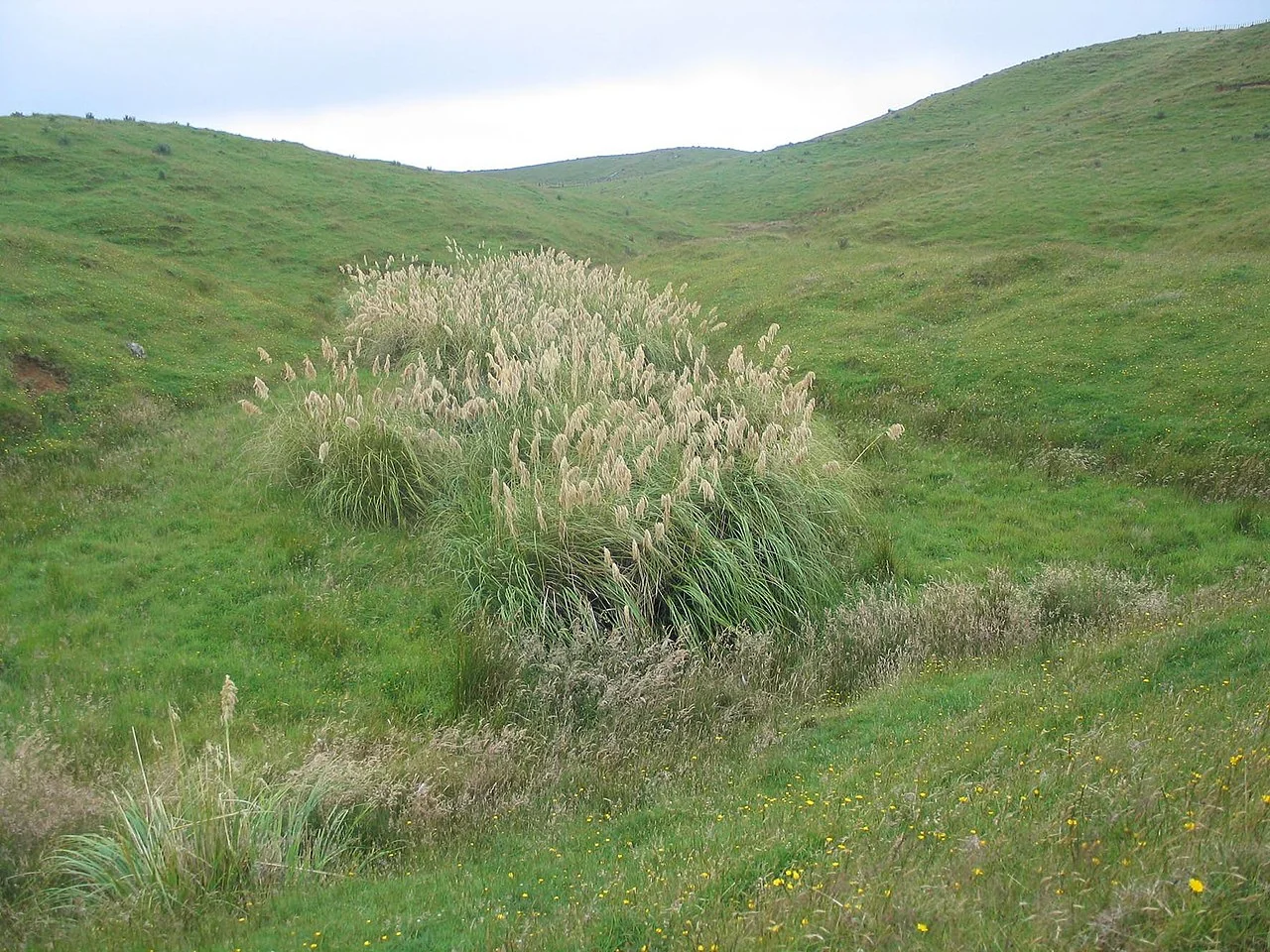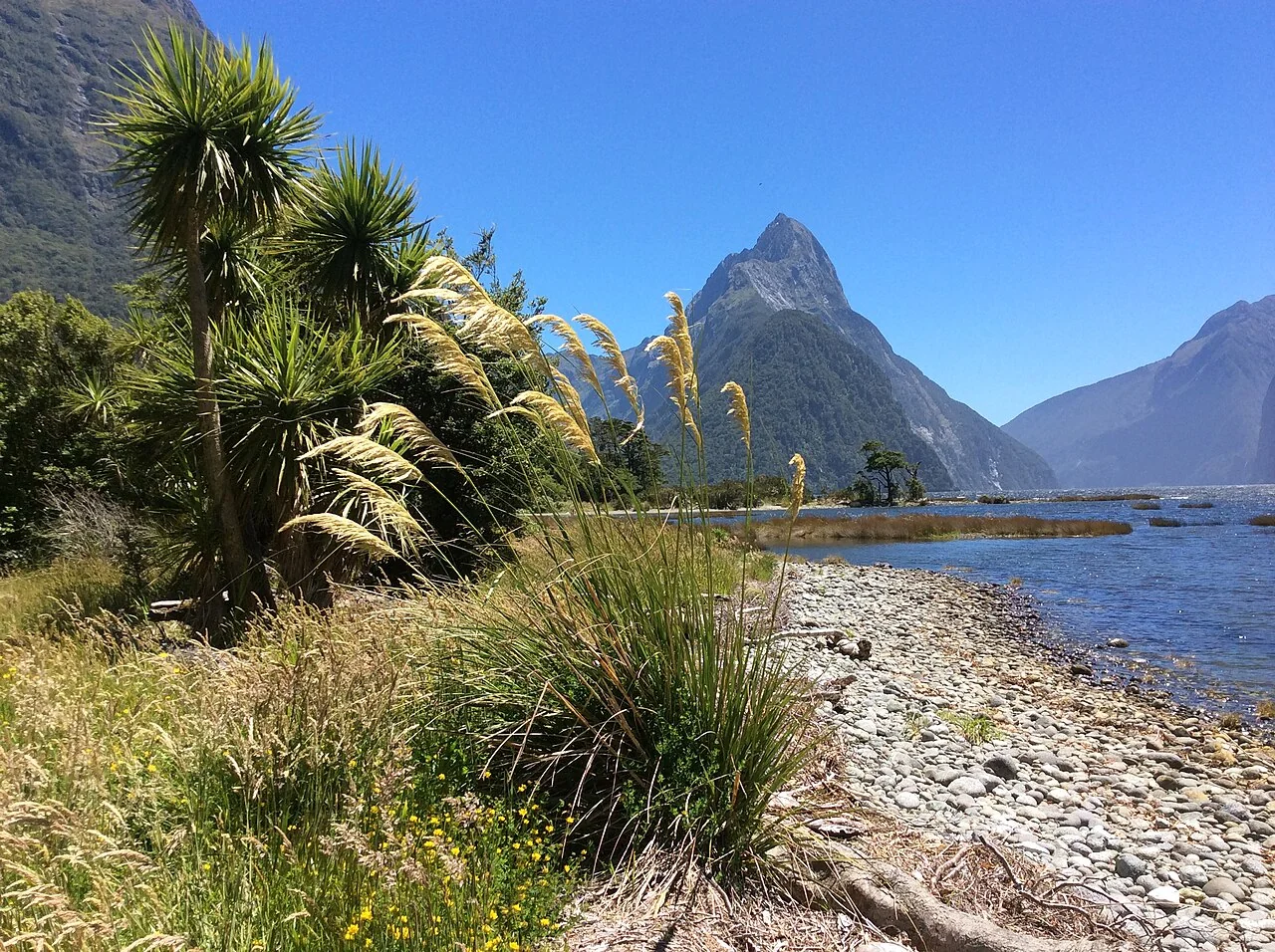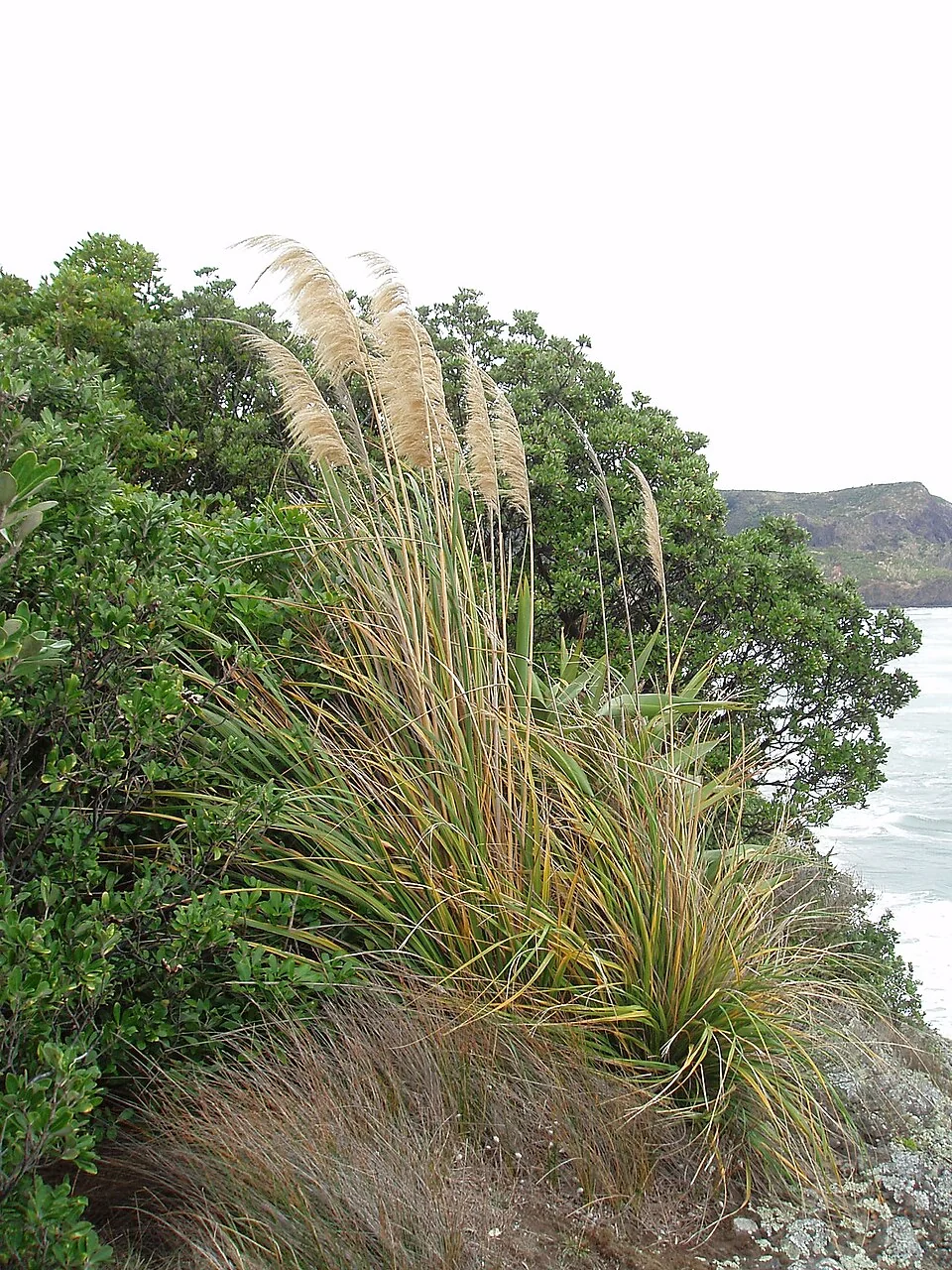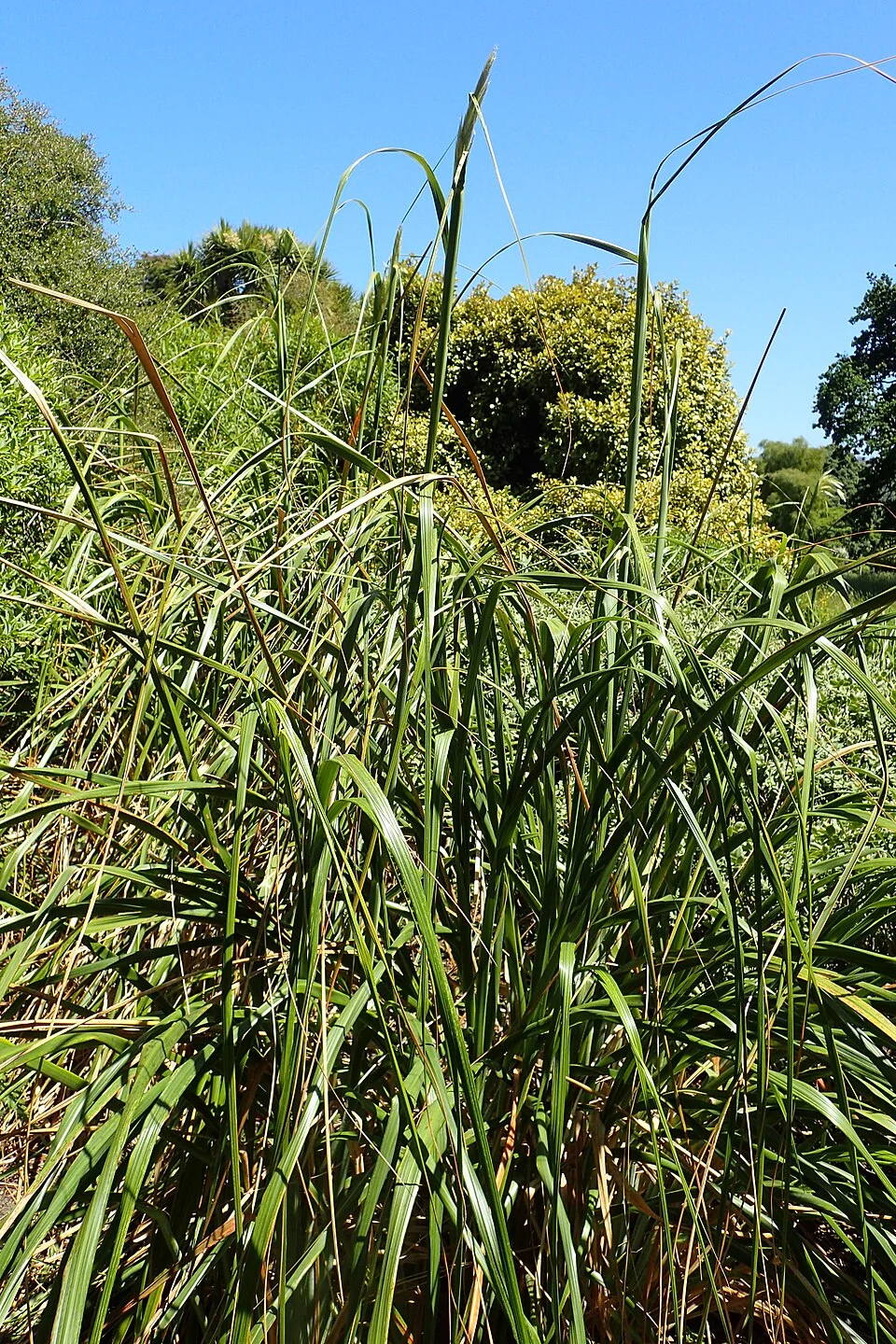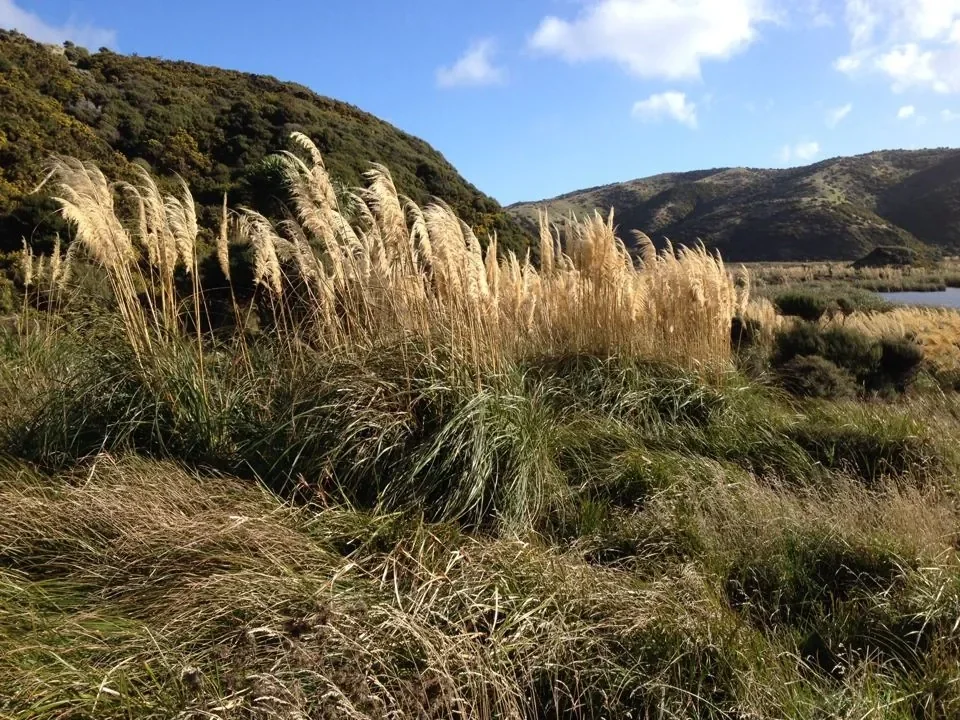
Toetoe
Austroderia toetoe
Explore more NZ native plant guides in our index .
Introduction
About Toetoe
Austroderia toetoe , commonly known as Toetoe, is an iconic native New Zealand grass. It forms large, graceful clumps of long, arching leaves and produces impressive plumes of golden-brown flowers that can reach up to 3 meters in height. Toetoe is a prominent feature of wetlands, riverbanks, and coastal areas, and is highly valued for its ornamental qualities and ecological importance.

Plant Description
Botanical Features
Austroderia toetoe , or Toetoe, is a large, clump-forming perennial grass native to New Zealand. It is renowned for its tall, feathery flower plumes that emerge in spring and summer, reaching heights of up to 3 meters. The plumes are initially a soft, golden-sheen and gradually fade to a pale cream. The leaves are long, narrow, and sharp-edged, forming a dense tussock at the base. This iconic plant is a key feature of New Zealand's wetlands and coastal areas, providing important habitat for native wildlife.
Quick Facts
Plant Summary
| Scientific Name | Austroderia Toetoe |
|---|---|
| Height | 2-3 m |
| Spread | 1-2 m |
| Water Needs | Moderate to high; prefers consistently moist soil |
| Light | Full sun to partial shade |
| Frost Tolerance | Moderate |
| Salt Tolerance | High |
| Growth Rate | Fast |
| Lifespan | Perennial |
Climate Best Suited to
Austroderia toetoe is found throughout New Zealand in a variety of habitats, including wetlands, riverbanks, and coastal areas. It thrives in a mild, temperate climate with consistent moisture and is particularly tolerant of coastal conditions, including salt spray.
Regional Suitability
| City | Climate Suitability |
|---|---|
| Whangārei | Ideal |
| Auckland | Ideal |
| Hamilton | Ideal |
| Tauranga | Ideal |
| Rotorua | Ideal |
| Gisborne | Ideal |
| New Plymouth | Ideal |
| Napier | Ideal |
| Whanganui | Ideal |
| Palmerston North | Ideal |
| Wellington | Ideal |
| Nelson | Ideal |
| Christchurch | Ideal |
| Dunedin | Ideal |
| Invercargill | Ideal |
Habitat
Natural Distribution
Austroderia toetoe , commonly known as Toetoe, is a prominent native New Zealand grass that thrives in a variety of wet and coastal environments. It is specifically restricted to freshwater swamps and wet areas, ranging from sea level to lower montane habitats, predominantly found in the North Island. This species is often observed growing alongside flax ( Phormium tenax ), forming dense stands that contribute significantly to the biodiversity of these ecosystems. While Austroderia toetoe itself has a more specific habitat preference, other closely related Austroderia species can be found in a wider range of habitats across New Zealand, including coastal areas, sand dunes, grasslands, stream banks, river beds, and lake margins. These grasses are highly adaptable to coastal winds and various soil conditions, inhabiting areas from the coast up to subalpine zones. Their extensive root systems play a crucial role in soil stabilization, particularly in erosion-prone areas.
Plant Conservation
Threats and Efforts
Toetoe ( Austroderia toetoe ) is a native New Zealand grass with a national conservation status of "Not Threatened." This classification reflects its relatively stable distribution across wetland and coastal habitats throughout New Zealand, particularly in the North Island where it is most abundant.
Despite its secure national status, regional conservation efforts are important as toetoe faces ongoing challenges from habitat loss, wetland drainage, and competition from invasive species, particularly South American pampas grass ( Cortaderia species) which can outcompete native toetoe in disturbed areas. The most significant conservation challenge comes from habitat destruction through urban development, agricultural conversion, and wetland modification. Conservation efforts focus on protecting and restoring wetland habitats, controlling invasive pampas grass populations, and promoting the use of authentic native toetoe in restoration projects rather than exotic alternatives. Its popularity in restoration projects contributes positively to its conservation, as increased cultivation helps maintain genetic diversity and provides seed sources for ongoing restoration efforts. Education about distinguishing native toetoe from invasive pampas grass is crucial for conservation success. By supporting wetland protection, responsible cultivation practices, and invasive species control, we can help ensure the continued survival of this culturally and ecologically significant native grass.
Growing Requirements
Soil Requirements
Prefers moist, well-drained, fertile soil with good organic content. Tolerant of a wide range of soil types, including sandy and clay soils.
Light Requirements
Grows best in full sun but will tolerate partial shade.
Water Requirements
Requires consistent moisture, especially during dry periods. Do not allow the soil to dry out completely.
Planting Guide
-
When to Plant
Plant in autumn or spring.
-
Site Preparation
Choose a sunny or partially shaded site with moist, well-drained soil.
-
Planting and Aftercare
Dig a hole twice the width of the pot. Place the plant in the hole and backfill with soil. Water well and apply a layer of mulch.
Ecological Significance
Austroderia toetoe , commonly known as Toetoe, holds significant ecological importance in New Zealand's diverse ecosystems. This native grass plays a crucial role in habitat creation, erosion control, and supporting biodiversity.
- Habitat and Shelter Provider: Toetoe forms dense tussocks that offer structure and shelter for a variety of native wildlife, including birds, insects, and other invertebrates. It provides cover and nesting sites, particularly for ground-nesting bird species.
- Erosion Control and Stabilization: With its extensive root systems, Toetoe effectively binds soil, intercepts runoff, and helps stabilize banks along waterways, coastal dunes, and other disturbed areas, thereby preventing erosion.
- Wetland Keystone Species: It is considered a fundamental species in New Zealand's wetland ecosystems, often acting as a pioneer species that colonizes disturbed wetland sites.
- Food Source: The plant's plumes produce abundant seeds that are dispersed by wind and serve as a food source for a wide range of endemic and exotic bird species, especially during summer. It also supports insects and other small invertebrates.
- Adaptability and Resilience: Toetoe is highly adaptable, thriving in various conditions from coastal dunes to subalpine environments. It demonstrates remarkable tolerance to drought, frost, and coastal exposure, and can grow in diverse soil types, including poor soils and coastal sand. Its resilience allows it to regenerate quickly after disturbances such as fire.
- Windbreaks: In agricultural settings, established clumps of Toetoe can serve as effective windbreaks, offering protection for livestock and crops.
It is important to differentiate native Austroderia toetoe from invasive South American pampas grass ( Cortaderia species), which can outcompete native flora.
Uses
Māori Heritage and Modern Use
Austroderia toetoe (the type species) shares the rich cultural history of the genus. The golden-yellow flower stems (kākaho) are the primary material for the horizontal elements in traditional tukutuku panels in meeting houses. The leaves were used for weaving baskets and mats, and the fluffy seeds had medicinal applications for stopping bleeding. Today, it is widely used in revegetation for erosion control and as a hardy low shelterbelt.
Landscaping Uses
Garden Design Applications
Austroderia toetoe , commonly known as Toetoe, is a highly valued native New Zealand grass with numerous landscaping applications, primarily due to its impressive size, graceful appearance, and remarkable hardiness. Its versatility makes it suitable for a variety of garden styles and functional purposes.
- Ornamental Feature: Toetoe's tall stature and spectacular feathery plumes create dramatic seasonal displays, adding height, movement, and visual interest to large gardens, meadows, and modern landscapes. It serves as an excellent focal point or backdrop plant.
- Erosion Control and Stabilization: With its extensive and fibrous root systems, Toetoe is exceptionally effective at binding soil and preventing erosion. It is an ideal choice for stabilizing banks along waterways, stream banks, coastal dunes, and other fragile or disturbed substrates.
- Wetland and Riparian Plantings: Thriving in moist to wet conditions, Toetoe is an excellent choice for wetland margins, boggy areas, and planting alongside streams, ponds, and swales, where it contributes to the natural aesthetic and ecological health of these environments.
- Windbreaks and Shelter: Being highly wind-tolerant and able to withstand coastal conditions, Toetoe is well-suited for creating low shelter belts and effective windbreaks, offering protection to more delicate plants or exposed areas.
- Wildlife Habitat: The dense tussocks formed by Toetoe provide valuable shelter and nesting material for various birds, insects, and other wildlife, enhancing biodiversity in the garden. Its seeds also serve as a food source for native birds.
- Screening and Garden Rooms: Its substantial size allows it to be used for screening purposes, providing privacy or defining distinct spaces within a garden, thereby creating "garden rooms."
- Mass Plantings: Toetoe looks particularly striking and creates a strong visual impact when planted in groups or in mass, accentuating its natural clumping habit and feathery plumes.
- Container Planting: While large, smaller varieties or individual plants can be grown in large containers to serve as focal points in smaller gardens or on patios.
- Restoration Projects: It is a highly suitable species for revegetation and restoration efforts, especially in disturbed or coastal areas, contributing to the recovery of native ecosystems.
Toetoe's adaptability to various soil conditions, including poor soils, and its resilience to drought once established, further enhance its value in landscaping. It is crucial to distinguish native Austroderia toetoe from invasive pampas grass ( Cortaderia species) to ensure the promotion of native flora.
Seasonal Care Calendar
Spring
- Remove any dead leaves and apply a balanced fertilizer.
Summer
- Water regularly, especially during dry periods.
Autumn
- The plumes will ripen and can be collected for propagation.
Winter
- Protect from heavy frosts in colder regions.
Pruning and Maintenance
Annual Cutback
Remove any old, damaged, or yellowing leaves as needed to maintain the plant's appearance. The plumes can be cut back in late winter or early spring to encourage new growth.
How to Grow Toetoe
Seeds
Seed propagation is remarkably easy and highly successful for Toetoe, making it the preferred method for both restoration projects and garden cultivation. This robust New Zealand native grass produces abundant viable seeds that require no pre-treatment and germinate readily under suitable conditions. Fresh seeds provide the best germination rates, so collect seed heads when they are fully mature and golden, typically during late summer to autumn. The most straightforward collection method involves shaking mature seed heads directly into a large bag, capturing the numerous small seeds for immediate sowing. For restoration projects, an even simpler approach involves pinning fresh seed heads directly to prepared soil surfaces and keeping them damp, allowing natural seed dispersal and germination to occur in situ. For controlled propagation, sow seeds on a firm bed of quality seed-raising mix, barely covering them with a light layer of growing medium as they require some light for optimal germination. Seeds can also be scattered directly on the soil surface and kept consistently moist until germination is complete, which typically occurs within 2-4 weeks under favorable conditions. Maintain steady moisture without waterlogging, and provide bright light but not direct scorching sun during the germination period. Young seedlings establish rapidly and grow vigorously under suitable conditions, often reaching substantial size within their first growing season. This method is particularly valuable for large-scale revegetation projects in wetland areas, coastal dunes, and erosion-prone sites where Toetoe's extensive root system provides excellent soil stabilization. The ease of seed propagation makes it accessible to gardeners of all skill levels and provides an economical way to establish large stands of this attractive native grass for both practical and ornamental purposes.
Division
Division provides an excellent alternative propagation method for Toetoe, particularly valuable when working with established clumps that have proven successful in specific growing conditions or when immediate impact is desired. This robust grass naturally forms substantial clumps through vigorous rhizome growth, creating multiple growing points that can be separated to form independent plants. The optimal timing for division is during spring when new growth is beginning to emerge, allowing divided sections to establish quickly in favorable growing conditions. Begin by carefully lifting the entire clump using a sturdy spade or fork, working around the perimeter to preserve as much of the extensive root system as possible. Toetoe develops a substantial and deep root network that provides excellent drought tolerance and soil stabilization, making complete extraction challenging but worthwhile for the health of the divisions. Once lifted, examine the clump to identify natural division points where separate growing centers have developed. Use a sharp spade or large knife to cut through connecting rhizomes, ensuring each division includes both healthy roots and multiple growing shoots for best establishment success. Divisions can be quite generous in size, as larger sections establish more quickly and provide immediate visual impact in landscape settings. Each division should have sufficient root material to support the substantial foliage load this species produces. Replant divisions immediately in prepared soil that suits the intended growing conditions, whether in wetland areas, garden borders, or erosion control sites. Choose locations that receive full sun to partial shade with adequate moisture, as Toetoe thrives in both wet and moderately dry conditions once established. Water thoroughly after planting and maintain consistent moisture during the establishment period, typically 6-8 weeks during favorable growing seasons. This method is particularly useful for creating uniform plantings where consistent appearance is important, or for sharing plants between gardeners interested in this valuable native grass.
Direct Seeding for Restoration
Direct seeding represents the most practical and cost-effective approach for large-scale restoration projects using Toetoe, taking advantage of the species' exceptional ability to establish from seed under natural conditions. This method is particularly valuable for wetland restoration, coastal dune stabilization, and erosion control projects where large areas need to be revegetated quickly and economically. The process involves collecting mature seed heads during peak seed production and either processing them for broader distribution or using them directly in the field. For immediate use, fresh seed heads can be pinned or scattered directly onto prepared soil surfaces in target restoration areas, then kept damp through natural rainfall or light irrigation until germination occurs. This approach mimics natural seed dispersal patterns and often produces excellent establishment rates with minimal intervention. For processed seeds, scatter them broadly across prepared restoration sites during favorable weather conditions, ideally in early autumn when natural moisture levels support germination. The extensive root system that Toetoe rapidly develops makes it particularly valuable for soil stabilization projects, as the deep, branching roots help prevent erosion while the above-ground growth provides habitat and visual screening. Monitor established areas for successful germination and growth, which typically becomes evident within 4-6 weeks of favorable conditions. Young plants may need protection from grazing animals during their first growing season, but once established, Toetoe forms robust stands that can withstand considerable environmental pressure. This method is especially important for conservation projects aimed at re-establishing native grass communities in areas where invasive pampas grass has been removed, as Toetoe can quickly colonize disturbed ground and prevent reinvasion by undesirable species. The simplicity and effectiveness of direct seeding make it an essential tool for restoration practitioners working with limited budgets and large areas requiring revegetation.
Pests and Diseases
Generally Hardy
Toetoe is typically robust and largely free of serious pests or diseases when grown in suitable conditions. In humid or crowded plantings, occasional leaf spot or light rust may appear; remove spent foliage, improve airflow, and avoid prolonged overhead watering to reduce recurrence. New growth can sometimes attract sap-sucking insects such as aphids; a firm water spray or application of a gentle horticultural oil usually resolves outbreaks quickly. Maintain healthy soil, adequate spacing, and seasonal clean-ups to keep plants in peak condition.
Cultural Significance
Traditional Uses and Values
Toetoe ( Austroderia toetoe ) holds significant cultural value for Māori. The leaves were used for weaving baskets, mats, and other items. The flower stalks were used for thatching and as shafts for arrows. The plant was also used in traditional medicine (rongoā).
Bonus Tip
Distinguishing Toetoe from Invasive Pampas Grass
It's crucial to differentiate native New Zealand Toetoe ( Austroderia toetoe ) from invasive South American Pampas Grass ( Cortaderia species), as they are often mistaken for each other. Here are key differences:
- Flower Plumes: Toetoe has gracefully drooping, pennant-shaped plumes that are typically creamy-white to pale yellow. Pampas grass plumes are usually erect, dense, and fluffy, ranging from white to pink or mauve.
- Flowering Season: Toetoe generally flowers from September to January (New Zealand spring/early summer). Pampas grass flowers later, from January to June (New Zealand autumn/winter).
- Leaves: Toetoe leaves have multiple prominent veins and are tough, not easily snapping when tugged. Pampas grass leaves have a single conspicuous mid-rib and tend to snap readily, with dead leaves curling up like wood shavings at the base.
Remember, Toetoe holds significant cultural and ecological importance in New Zealand, while pampas grass is an invasive weed.
